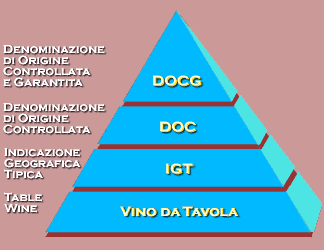
This deep-seated viniculture comes with a complex classification system that ensures quality and authenticity. For those wanting to understand the world of Italian wines, it is crucial to grasp this system. In this post, we will delve into Italy’s wine classification system.
 Italy’s wine classification system comprises four main categories, which, in descending order of quality and strictness of production rules, are DOCG, DOC, IGT, and Vino.
Italy’s wine classification system comprises four main categories, which, in descending order of quality and strictness of production rules, are DOCG, DOC, IGT, and Vino.
This is the pinnacle of Italian wine classifications. Wines that earn DOCG status are considered of the utmost quality, and they have to adhere to stringent production guidelines. This classification not only verifies the area of origin but also ensures that the wine underwent a taste test to ensure its excellence. Every DOCG bottle features a numbered government seal, which is a mark of its authenticity and quality.
DOC wines represent a significant portion of Italian premium wines. While not as stringent as DOCG, the DOC classification still demands strict adherence to particular production techniques, grape varieties, and yield limits. Essentially, a DOC label guarantees the wine’s origin and that it meets quality production standards for that specific region.
This classification allows for more flexibility than DOC or DOCG. Introduced in the 1990s, the IGT category was designed to accommodate wines that may not meet the strict criteria of DOC or DOCG but are of high quality. It often includes innovative blends that don’t align with traditional regional norms. An IGT label signifies the wine’s geographical origin without the stringent rules associated with the higher classifications.
This is the most basic classification, often referred to as “table wine.” Wines under this category do not follow the specific production standards set by the higher classifications. While it may sound unremarkable, many delicious and high-value wines fall under this category. It’s essential not to dismiss them outright.
While the above classifications provide a broad overview, the real magic in Italian wines comes from understanding the regional variations. For instance:
– Tuscany: Known for its iconic Chianti (DOCG), it also produces Super Tuscans, which are often classified as IGT because they don’t adhere to traditional blending rules but are still of superb quality.
– Piedmont: This region boasts the prestigious Barolo and Barbaresco, both of which are DOCG wines. Made from the Nebbiolo grape, they are lauded for their depth and longevity.
– Veneto: This region is renowned for Prosecco, Italy’s sparkling wine darling, and Amarone della Valpolicella, a robust red wine made using a unique drying process for grapes.
While it might seem intricate and, at times, overwhelming, the Italian wine classification system serves a vital purpose. It offers assurance of quality and origin for consumers and provides a framework for producers to showcase their best. Each classification tells a story, and knowing this system can deepen the appreciation of every bottle.
Italian wines are a treasure trove of history, flavor, and diversity. By understanding the classification system, wine enthusiasts can navigate this vast landscape with confidence, ensuring that every sip is savored to the fullest. So, the next time you pick up an Italian wine, let its label tell you its story – from the rolling hills of Tuscany to the terraced vineyards of Piedmont. Cheers to the rich tapestry of Italian wines!

All things wine, and food you could ever need or want — straight to your email!